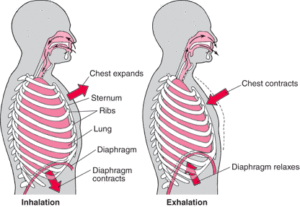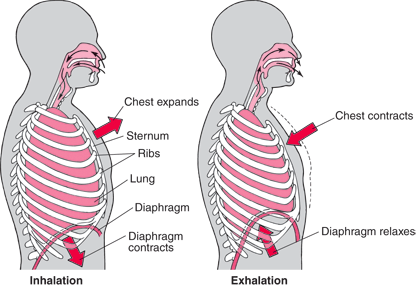Rebound Breath: Technique for Singers and Wind Players
Rebound Breath: Technique for Singers and Wind Players
For wind players and singers, finding places to breathe is a constant struggle. We must balance the demands of the phrase with the physical limitations of our lungs. In an idea world, we would be able to take long, full breaths at the end of every perfectly spaced phrase of music. But sometimes our lungs run out of air or before the end of the phrase. In these instances, we might consider using a rebound breath. The advantage of the rebound breath is that it is very fast, but it takes in less air than a full breath.
In the highlighted passage below, singers need to take a quick breath without distorting the rhythm or phrase. This is the perfect place to use a “rebound breath.”
Exercise for Practicing the Rebound Breath
- Exhale completely.
- When the lungs are nearly empty, retain the breath for a moment.
- While holding your breath, keep the ribcage expanded. Lift the sternum. You may feel some negative pressure (vacuum).
- Still holding the breath, relax the intercostal muscles.
- Open the mouth and throat and hear a quiet “pop” as the air rushes into the lungs to fill the vacuum.
The important thing is to not try to suck air in. Simply allow it to rush in to fill the space you have created with the open ribcage and relaxed intercostal muscles. (I avoid talking about the “diaphragm” here for many reasons. Think instead of relaxing the muscles between the ribs and through the abdomen instead.)
Steps 3-4 will happen simultaneous with the exhale as this technique becomes easier. Step 2 will disappear in a true rebound breath. The result is a quick breath at the moment you need it: when you are out of air in the middle of a phrase.
A Shampoo Bottle
Imagine a shampoo bottle. You can squeeze the air out and close the lid. Inside the bottle, a vacuum is created by the rigid plastic walls which want to return to their expanded shape. If you release the lid, air will rush in and the bottle will pop back to normal.
The same thing happens when I travel from Denver, Colorado to Columbus, Ohio. Denver is 5280′ above sea level and Columbus is about 900′ above sea level. All of my plastic bottles of lotion, sunblock, hand sanitizer, etc. are squished when I arrive home. Unsealing each, I hear a pop as the air rushes in.
Your lungs are like these plastic bottles. If you create an open structure with the ribs and relax the muscles, air will rush in to fill the void.
Considerations
Note that the rebound breath will not be as full as a leisurely breath where the ribs can pivot open. The rebound breath should only be used when a fast breath is needed but the next phrase won’t be uncomfortably long.
The goal is to let the air rush in by itself. Do not try to inhale or fill the lungs all the way to the top. Again, this is not a full breath but a quick emergency fill-up.
Keep the sternum lifted during the exhale. In the diagram at the right, the ribs are lowered on the exhale. See if you can keep the entire ribcage lifted to create as much vacuum as possible. Allow the diaphragm to do the work of pressing the air out of the lungs.
The rebound breath should be nearly silent. If you hear noise, the throat might be tight. Be sure to relax the muscles of the throat and neck.
For this quick breath, the chest may not move much. The belly may have a little bounce as the air rushes in as the diaphram descends.
More On Breathing
I also talk about breathing in the following blog article:
Books with chapters on breathing in general:
- Arnold Jacobs: Song and Wind by Brian Frederiksen
- Vocal Technique: A Guide for Conductors, Teachers, and Singers by Julia Davids and Stephen LaTour
- Illustrated Fluteplaying by Robin Soldan and Jeannie Mellersh
- Body Mapping for Flutists: What Every Flute Teacher Needs to Know About the Body by Lea Pearson, DMA
Do you use rebound breathing? Let me know what you think.


No comments.